Building a Collection #71
Concierto de Aranjuez
By Joaquin Rodrigo
________________
I am so happy you could join me for another installment of Building a Collection! We have arrived at #71 on our list, but the first composition by a Spanish born composer. The work is the Concierto de Aranjuez, a concerto for guitar by Joaquin Rodrigo. This charming, lyrical, and evocative work is one of my favorite concertos of any kind and may become a favorite of yours as well.
Joaquin Rodrigo
Joaquin Rodrigo (1901-1999) was born in Sagunto, Spain (in the Valencia province). At the age of three, Joaquin lost his sight after a bout of diphtheria. Rodrigo began piano studies at the age of eight and then studied theory and composition at 16. Despite the fame he would bring to the classical guitar, Rodrigo himself never mastered the instrument, although he became an accomplished pianist. To compose, he would write in Braille, and that would be transcribed.
Rodrigo began composing in 1923. From 1947 on, Rodrigo served as a professor of music theory at the University of Madrid. His most famous work, the Concierto de Aranjuez, dates from 1939. In 1954, Rodrigo produced his Fantasia para un gentilhombre at the request of famous guitarist Andrés Segovia. A later work, his Concierto Andaluz for 4 guitars and orchestra, was commissioned by Celedonio Romero for performance by the Romero guitar quartet (Celedonio was the father, and he was joined by his sons Angel, Celin, and Pepe, all of whom would go on to solo guitar careers), and was premiered in San Antonio, Texas in 1967.
In 1983 Rodrigo was awarded Spain’s highest honor for composition, the Premio Nacional de Música. In 1996 Rodrigo received the prestigious Prince of Asturias Award, Spain’s highest civilian honor.
Concierto de Aranjuez
Rodrigo’s greatest work, the Concierto de Aranjuez, dates from 1939 while he was in Paris. In 1939, the Spanish Civil War was ending, and the Franco regime began its reign. Thus, any piece of music being premiered at the time was critically assessed to be sure it gave the Franco regime as much of a positive image as possible. Nothing controversial would be tolerated, and fortunately for Rodrigo, there was no problem with his choice of themes.
The work was written for, and premiered by, guitarist Regino Sainz de la Maza, who would later go on to make the first recording for the piece in 1947. The premiere was held in November 1940 in Barcelona. It was performed by guitarist Sainz de la Maza with the Orquesta Filarmónica de Barcelona conducted by César Mendoza Lasalle. The United States premiere was given by Rey de la Torre in November 1959, with the Cleveland Orchestra under Robert Shaw.
The classical guitar is rather underrepresented in concerto form, maybe because it is not ideally suited to a concerto since the timbre and volume of the classical guitar is easily washed over by the orchestra. But Rodrigo’s Concierto De Aranjuez shows us that it is very much possible to write a masterful concerto for classical guitar.
The inspiration for the concerto reportedly comes from the Royal Palace of Aranjuez, the spring resort palace built by Philip II in the last part of the 16th century and then rebuilt by Ferdinand VI in the 18th century. In trying to paint a sound picture of the palatial grounds, Rodrigo primarily chooses to highlight sounds and sensations from nature, including the singing of birds, the smell of magnolias, and flowing fountains.
According to the composer’s own comments on the concerto, the first movement is "animated by a rhythmic spirit and vigour without either of the two themes... interrupting its relentless pace"; the second movement "represents a dialogue between classical guitar and solo instruments (cor anglais, bassoon, oboe, horn etc.)"; and the last movement "recalls a courtly dance in which the combination of double and triple time maintains a taut tempo right to the closing bar."
Unlike many concertos you might hear, the central Adagio is really the heart of this piece and is nearly as long as the outer two movements combined. The austere and haunting Adagio is considered by many to be one of the most beautiful movements in all of music and is the most well-known of the three movements. There is a feeling of regret, longing, and melancholy throughout the movement, and it has been confirmed that Rodrigo wrote this movement as a response to the tragedy and heartbreak of he and his wife losing their first child through a miscarriage. In a minor key, it is slow in pace and soft in melody, and even though different parts are added throughout, it always returns to the main melody. After a period of calm, and a buildup on the guitar, it is the orchestra which returns to resolve the movement at the end. The movement leaves an indelible mark on the listener, and it is what lifts the entire piece to greatness.
Portions of the concerto, especially the Adagio, have been used or adapted by other musicians. Most famously, jazz musician Miles Davis made his own version of the Adagio for his 1960 album Sketches of Spain, along with arranger Gil Evans. Davis said of the melody, "That melody is so strong that the softer you play it, the stronger it gets, and the stronger you play it, the weaker it gets." A conflict soon arose because Davis’s record company Columbia had not obtained Rodrigo’s permission to use the piece for the album, and at least initially Rodrigo was irate. Eventually he realized that the jazz version only brought more recognition to the original composition, and so that helped resolve the issue. However, the composer’s wife, Victoria Kamhi, in her memoirs called Davis using the piece “an act of piracy” and that Joaquin had even attempted to file a lawsuit against the record company only to be told that since Davis gave credit to Rodrigo for the music in the album notes, there was no case.
There are countless other adaptations and versions for other instruments and groups. Even though this is a 20th century work, it has the hallmarks of what is known as “neo-classicism” in that the melodies and moods call upon tradition from past musical history. Rodrigo uses a somewhat conservative musical language and also uses some nationalistic sounding themes to remain true to his Spanish roots. But it is also thoroughly listenable and enjoyable for anyone, and I dare you to resist humming the tunes to this melodic and memorable work.
The Essential Recording
I was fortunate enough in the mid-1990s to attend a concert with the Boulder Philharmonic in Colorado that featured the soloist Pepe Romero on guitar and he and the orchestra played Rodrigo’s Concierto De Aranjuez. I had owned Romero’s first recording of the concerto with the Academy of St. Martin-in-the-Fields under Neville Marriner for a while, but I was unaware at the time that Romero and Marriner had re-recorded the concerto in 1992 for Philips (Universal) in digital sound. The second recording was indeed a significant improvement sonically as well as performance wise, and I have cherished this second recording ever since as something of a memento from the concert I attended, but also because the recording stands above all the many other excellent recordings of this great concerto.
Like so many great works, the Concierto De Aranjuez has received so many excellent recordings over the years that a recording has to be truly special in order to be essential. The Pepe Romero recording with the Academy of St. Martin-in-the-Fields under Sir Neville Marriner from 1992 is the one that checks all the boxes and for me is completely satisfying as a performance and in terms of recording quality. Romero is very much on point with his rhythm and strumming, and the level of detail he reveals is impressive. The ASMF under Marriner has rarely sounded better, and they complement Romero with their own crisp and atmospheric sound, recorded in the warm acoustic of Watford Town Hall in London. Indeed, the orchestral accompaniment here has rarely sounded more glorious with details abounding throughout. Romero is technically superb here, and he wrings every ounce of emotion from the Adagio in a piece that demands expression of emotion.
Recommended Recordings
I have a soft spot for John Williams and The Philadelphia Orchestra under Eugene Ormandy, recorded for CBS/Columbia/Sony in 1966 (Note: this is referring to John Christopher Williams, classical guitarist; not to be confused with John Williams the composer and conductor). This was Williams’ first recording, and I believe his best. It is true there is some persistent background hiss, but I still marvel at the wondrous playing of the Philadelphians at their peak under Ormandy. Moreover, I find Williams to be very effective at conveying the moods and rhythms inherent in the work.
Narciso Yepes was one of the first great guitarists to record the Concierto De Aranjuez in the 1950s, and he went on to record it several times. The best of these versions in my view is from 1979 with the Philharmonia Orchestra under Garcia Navarro. Warmly recorded by Deutsche Grammophon at Watford Town Hall in London (one of my favorite venues for recordings), Yepes brings a strong vision to the work, and I really enjoy the way he articulates the notes so well in the first movement. Yepes’ critics often said his playing was too clipped and staccato, and not romantic enough. I don’t agree, as the Adagio here is played with real tenderness and sentimentality, and the final Allegro is jaunty and danceable. The Philharmonia sounds great in this recording, even if recorded a bit too close. I found this very enjoyable.
Carlos Bonell and the Orchestre Symphonique de Montreal led by Charles Dutoit were recorded by Decca in 1980 in a recording that was greatly praised at the time, was awarded a Rosette by the Penguin Guide to CDs and remains a very competitive option today. Although the early digital sound can be a bit glaring in louder orchestral passages, Bonell brings great refinement and passion to his playing. The guitar sound is warm and rounded, and Dutoit and the OSM were particularly known for excelling in evocative music and they bring that same quality to Rodrigo’s score. Although perhaps not as purely exciting as Romero with Marriner, this is still highly recommendable.
The famous flamenco guitarist Paco de Lucia recorded the concerto with the Catalan based Orquesta De Cadaques in 1991 for Philips, certainly one of the best versions. Rodrigo himself gave this performance his highest assessment, and from a certain point of view it is utterly authentic. Paco de Lucia is undoubtedly one of the greatest guitar talents of the century, but for purists of “classical” guitar, at times he takes some liberties with the score. The bottom line is the changes he makes in phrasing and even in the somewhat different timbre of his guitar ultimately work out well, and this is a highly enjoyable version in better than average sound. I like that de Lucia makes you listen with renewed interest, and he brings his own special brand of artistry.
Cuban American guitarist Manuel Barrueco recorded Rodrigo’s Concierto de Aranjuez in 1996 with the Philharmonia Orchestra and the famous tenor/baritone Placido Domingo conducting, recorded in Air Studios in London for EMI (now on Warner). Marcus, one of my fabulous readers, reminded me about this recording and in listening to it again I find it has much to recommend it. Barrueco is immensely talented and expressive, and the Adagio in particular is played with much poignancy and heart, and his tone is ideal for this reflective and beautiful movement. The entire performance is nicely done. I have never been convinced by Domingo’s handful of outings on the podium, but this may be his best conducting on record. He encourages some truly gorgeous playing from individual parts of the orchestra, and on the whole, he gives the soloist plenty of space. The sound is not ideal in my opinion, as Barrueco is recorded more distantly than is my preference, and some of the detail is lost or difficult to hear. Certain instruments in the orchestra also seem too far back to me, but someone with better equipment than myself may not mind as much. But the performance itself is memorable.
Chinese guitarist Xuefei Yang and the Barcelona Symphony Orchestra and National Orchestra of Catalonia conducted by Eiji Oue were recorded in 2010 for EMI/Warner. Yang impresses with her technique and sensitivity to the score, and the greatly underrated conductor Oue leads a lovely accompaniment with the Barcelona orchestra. Yang’s playing is particularly heartfelt and passionate, and the faster passages are played with breathtaking virtuosity. Yang delves deep into the meaning of the phrases and the music as a whole. This is a fabulous performance, and the sound is warm and realistic.
Star guitarist Miloš Karadaglić is joined by the London Philharmonic Orchestra and conductor Yannick Nézet-Séguin in a 2014 release on Deutsche Grammophon that arrived with high expectations due to Milos’ star already having risen by this time. Milos does not disappoint. He and Nezet-Seguin take an essentially romantic approach, nothing is rushed, and the music is allowed to unfold naturally. Milos avoids the trap of being too flashy in the first movement, and in the all-important Adagio he finds the right mood with the orchestra interplay to create a haunting atmosphere. The final Allegro gentile moves along at a good clip and is dispatched with confidence. Nezet-Seguin wisely stays out of Miloš’ way for the most part. The sound is excellent.
Honorable Mention
Narciso Yepes / Orquesta Nacional de España / Ataúlfo Argenta (Artemisia 1957)
Julian Bream / Melos Ensemble / Colin Davis (Sony 1964)
Angel Romero / San Antonio Symphony Orchestra / Victor Alessandro (Decca 1967)
Narciso Yepes / Orquesta Sinfonica de RTVE / Odón Alonso (DG 1969)
Julian Bream / Monteverdi Orchestra / Sir John Eliot Gardiner (Warner 1975)
Pepe Romero / ASMF / Sir Neville Marriner (Philips/Universal 1979)
Sharon Isbin / Orchestre de Chambre de Lausanne / Lawrence Foster (Warner 1991)
Craig Ogden / BBC Symphony Orchestra / Sachio Fujioka (Chandos 1998)
Christoph Denoth / LSO / Jesús López Cobos (Signum 2015)
Jacob Kellerman / LPO / Christian Karlsen (BIS 2019)
Thibaut Garcia / Capitole de Toulouse / Ben Glassberg (Warner 2020)
_______________
Notes:
Goodman, Al (8 July 1999). "Joaquin Rodrigo, 97, Master Of Spanish Classical Music". The New York Times. p. B9. Retrieved 16 May 2023.
Michael Macmeeken. "Liner notes for CD,'Concierto de Aranjuez: The Premier Recording.'". Incidentally, Macmeeken gives the date of the premiere of the Aranjuez, by Sainz de la Maza in Barcelona, as 9 Oct. 1940.
Rodrigo, Victoria Kamhi de (1 March 1992). Hand in hand with Joaquín Rodrigo: my life at the maestro's side. Latin American Literary Review Press. ISBN 9780935480511.
Shaw, Robert (2008). Hand Made, Hand Played: The Art & Craft of Contemporary Guitar. Sterling Publishing Company, Inc. p. 30. ISBN 978-1-57990-787-7.



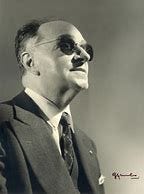
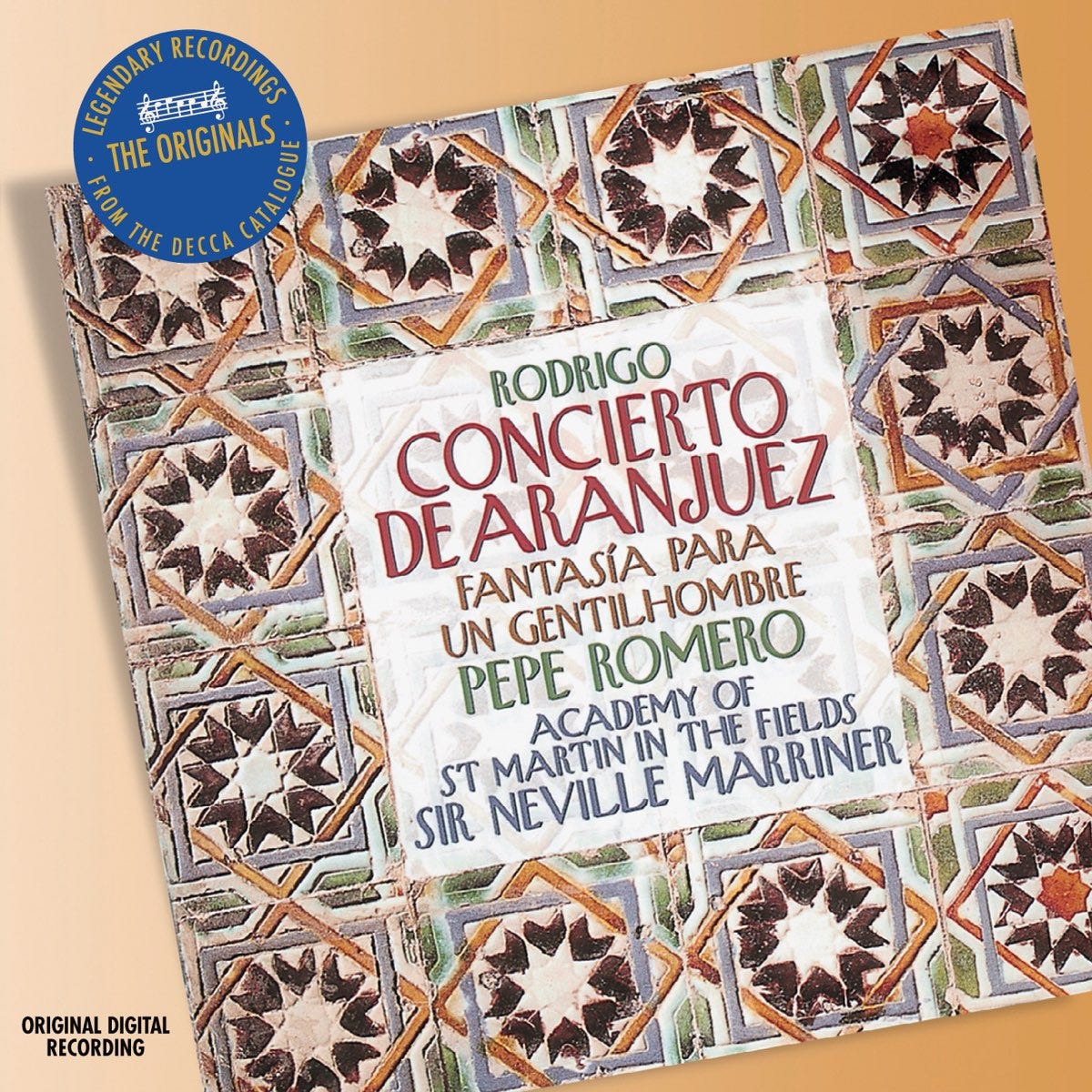
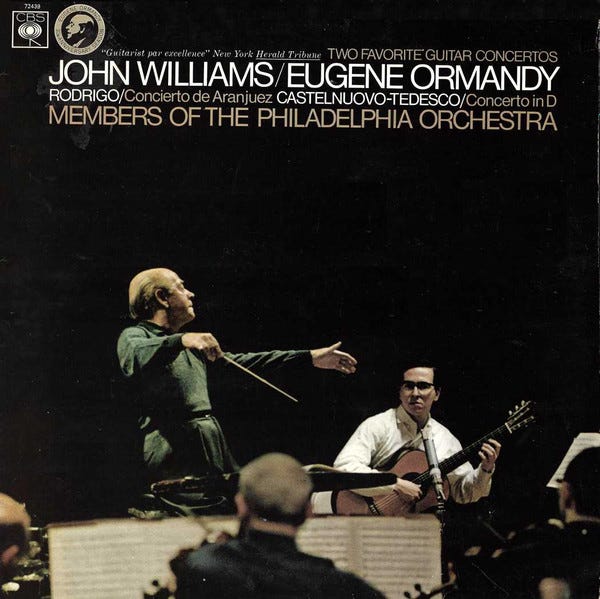
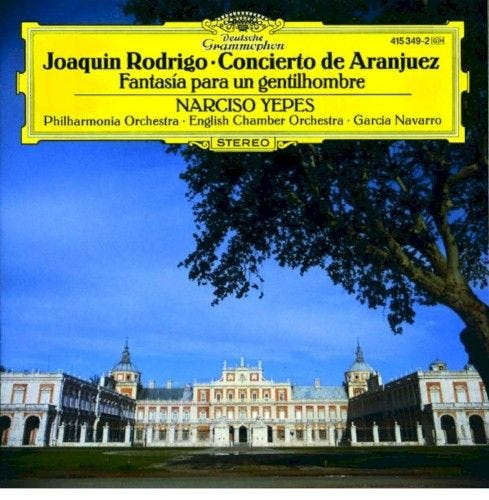
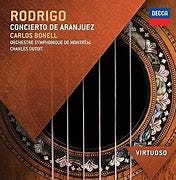
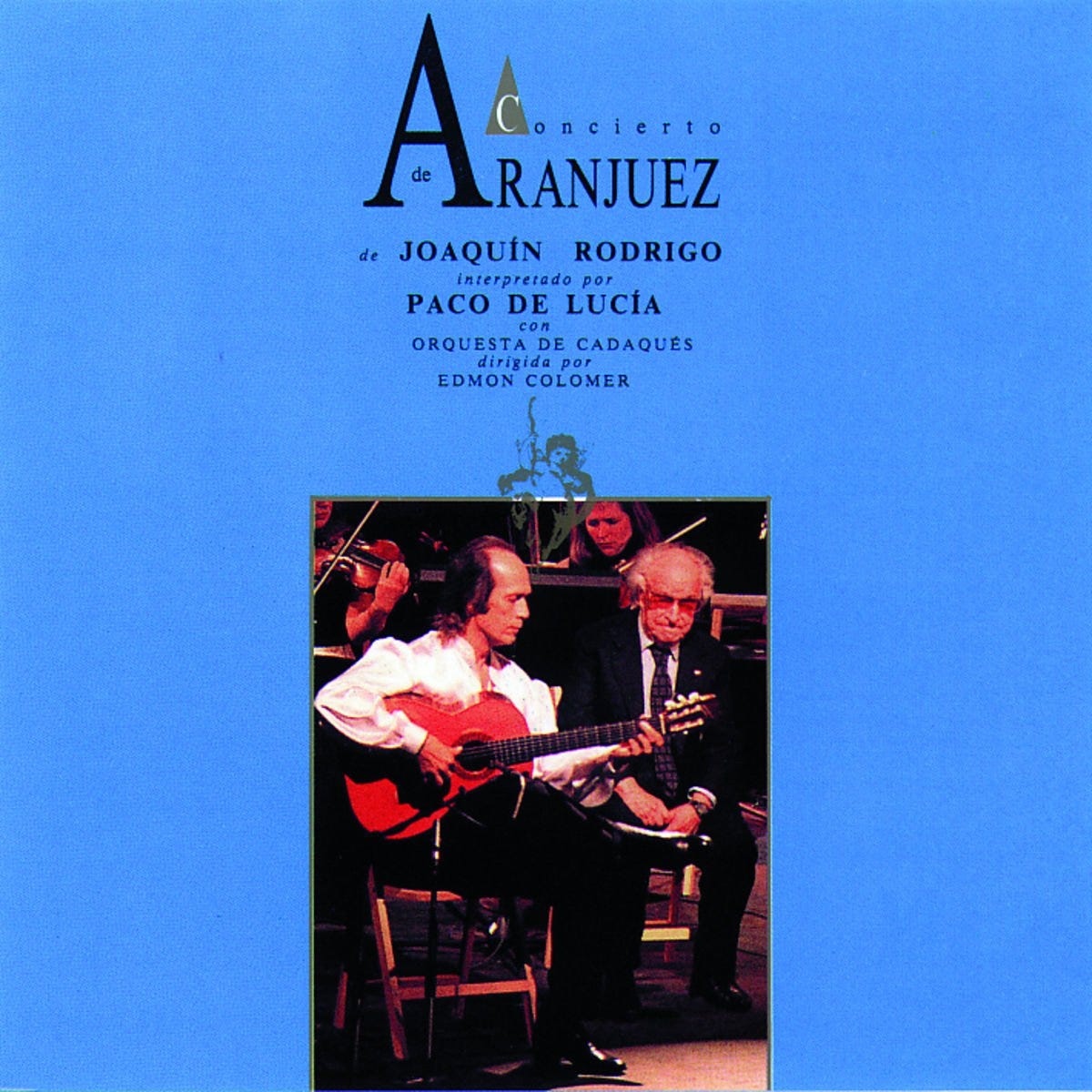
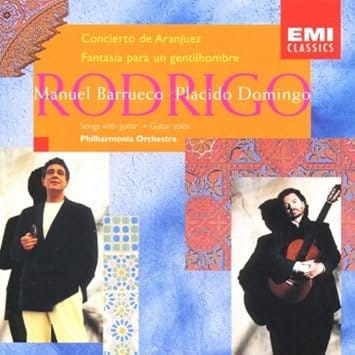
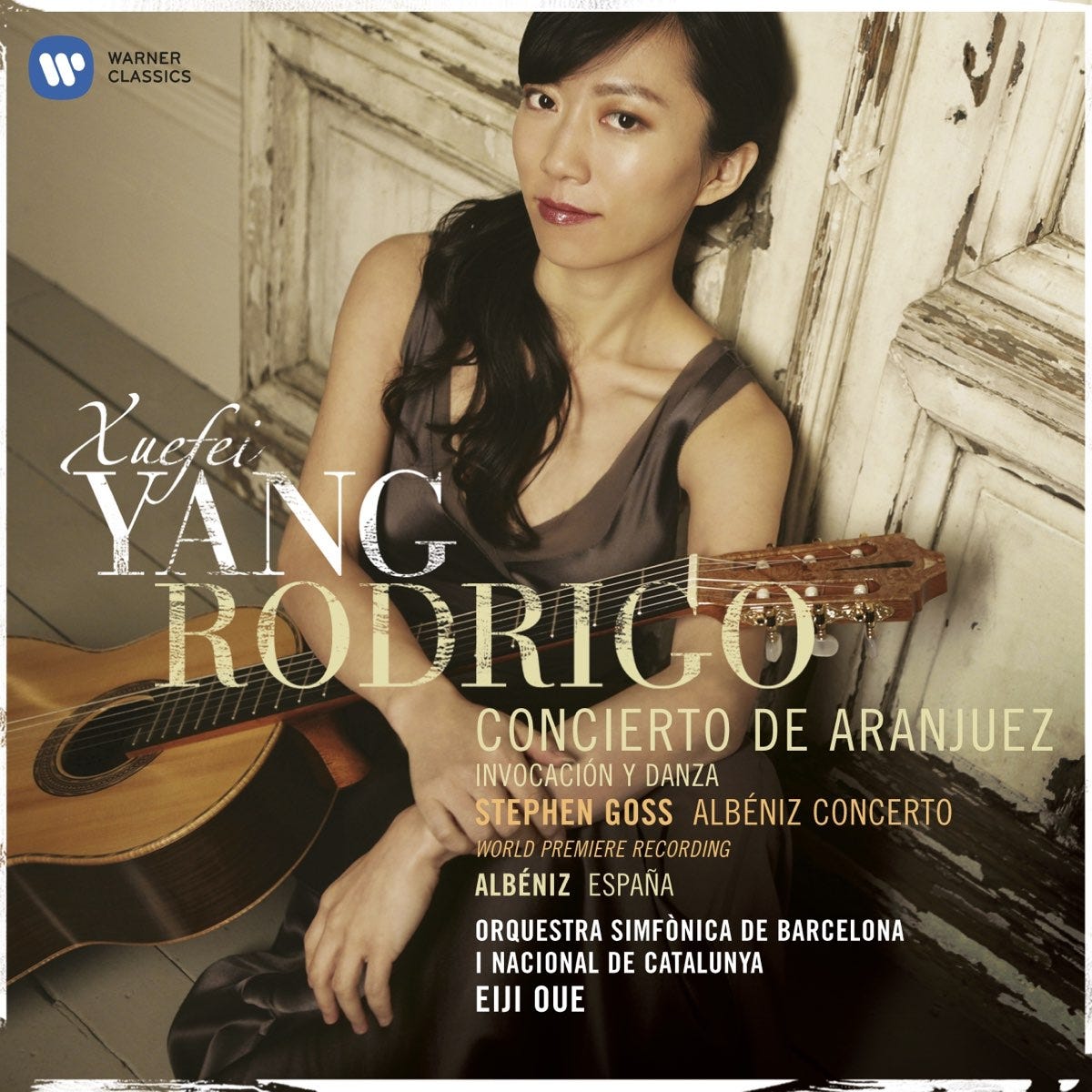
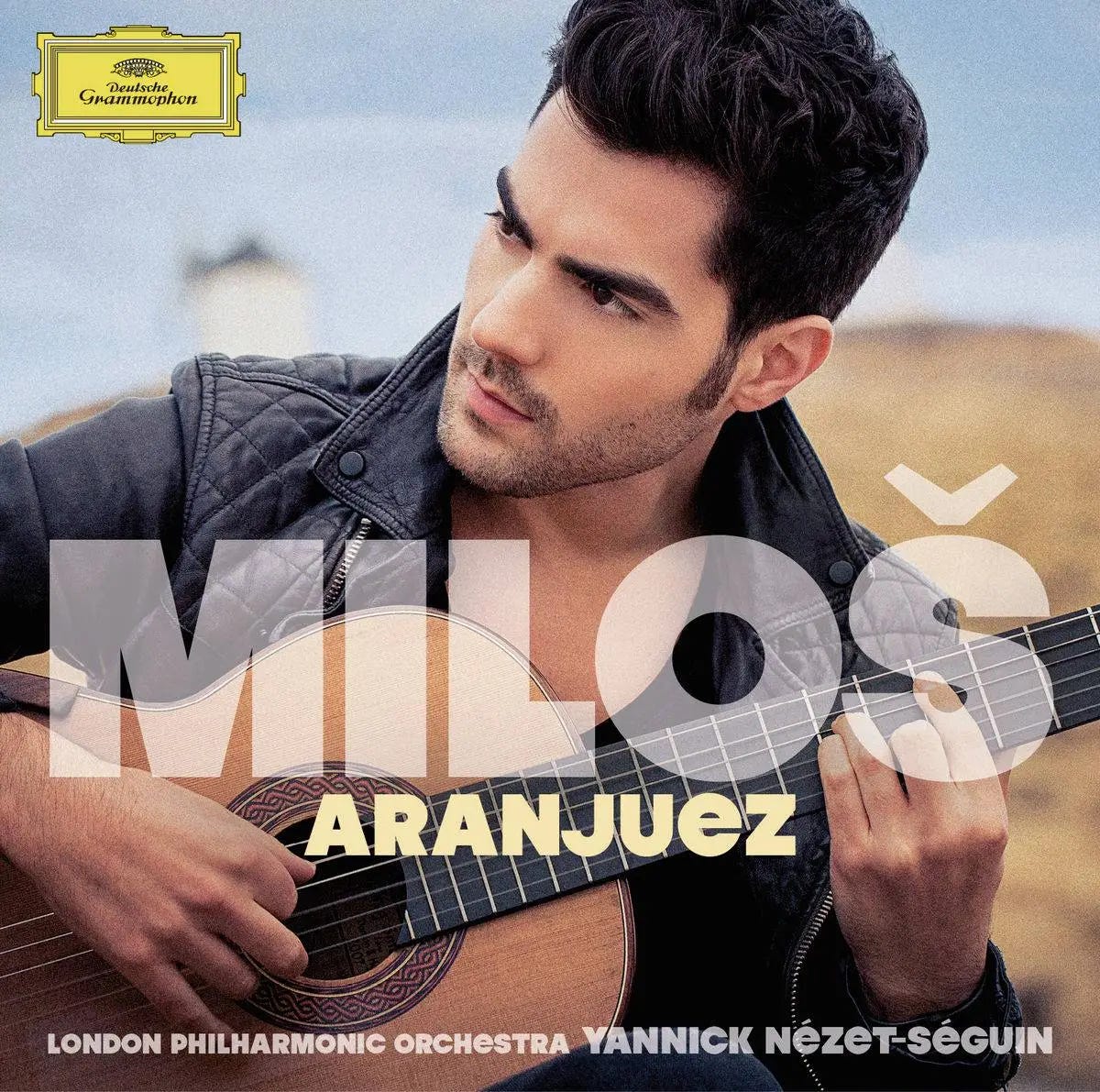
Hi John, could you tell me your thoughts on Sollscher's DG version with the Orpheus CO? It's an introspective and ruminative version that suits the music well.
Barrueco/Domingo is my favorite of all recordings. I noticed it wasn't even listed. So sad.